Silica-Gentamicin Nanohybrids: Synthesis and Antimicrobial Action
Abstract
:1. Introduction
2. Results and Discussion
2.1. Characterization of the SiO2-Gentamicin Nanohybrids and Native SiO2 NPs
2.2. The in Vitro Release Profile of Gentamicin from the SiO2-Gentamicin Nanohybrids
2.3. Antimicrobial Activity of the SiO2-Gentamicin Nanohybrids, SiO2 NPs and Free Gentamicin
2.3.1. Agar Diffusion Assay
2.3.2. MIC (Minimum Inhibitory Concentration) of the SiO2-Gentamicin Nanohybrids, Native SiO2 NPs and Free Gentamicin
2.3.3. Bactericidal Mechanistic Action of the SiO2-Gentamicin Nanohybrids versus Free Gentamicin
3. Materials and Methods
3.1. Synthesis and Characterization of the SiO2-Gentamicin Nanohybrids and Native SiO2 NPs
3.2. The in Vitro Release Studies of Gentamicin from the SiO2-Gentamicin Nanohybrids
3.3. Comparison of the Antimicrobial Action of the SiO2-Gentamicin Nanohybrids Versus Native SiO2 NPs and Free Gentamicin
3.3.1. Agar Diffusion Assay
3.3.2. Broth Microdilution Assay
3.3.3. TEM Interaction Studies of the SiO2-Gentamicin Nanohybrids, Native SiO2 NPs and Free Gentamicin with the Bacterial Cells
4. Conclusions
Supplementary Materials
Acknowledgments
Author Contributions
Conflicts of Interest
References
- Falaize, S.; Radin, S.; Ducheyne, P. In Vitro Behavior of Silica-Based Xerogels Intended as Controlled Release Carriers. J. Am. Ceram. Soc. 1999, 82, 969–976. [Google Scholar] [CrossRef]
- Radin, S.; Ducheyne, P. Controlled Release of Vancomycin from Thin Sol-Gel Films on Titanium Alloy Fracture Plate Material. Biomaterials 2007, 28, 1721–1729. [Google Scholar] [CrossRef] [PubMed]
- Thein, E.; Tafin, U.F.; Betrisey, B.; Trampuz, A.; Borens, O. In Vitro Activity of Gentamicin-Loaded Bioabsorbable Beads against Different Microorganisms. Materials 2013, 6, 3284–3293. [Google Scholar] [CrossRef] [Green Version]
- Radin, S.; Ducheyne, P.; Kamplain, T.; Tan, B.H. Silica sol-gel for the controlled release of antibiotics. I. Synthesis, characterization, and in vitro release. J. Biomed. Mater. Res. 2001, 57, 313–320. [Google Scholar] [CrossRef]
- Barbé, C.; Bartlett, J.; Kong, L.; Finnie, K.; Lin, H.Q.; Larkin, M.; Calleja, S.; Bush, A.; Calleja, G. Silica Particles: A Novel Drug-Delivery System. Adv. Mater. 2004, 16, 1959–1966. [Google Scholar] [CrossRef]
- Xue, J.M.; Shi, M. PLGA/mesoporous Silica Hybrid Structure for Controlled Drug Release. J. Control. Release 2004, 98, 209–217. [Google Scholar] [CrossRef] [PubMed]
- Gao, P.; Nie, X.; Zou, M.; Shi, Y.; Cheng, G. Recent Advances in Materials for Extended-Release Antibiotic Delivery System. J. Antibiot. 2011, 64, 625–634. [Google Scholar] [CrossRef] [PubMed]
- Aughenbaugh, W.; Radin, S.; Ducheyne, P. Silica Sol-Gel for the Controlled Release of Antibiotics. II. The Effect of Synthesis Parameters on the In vitro Release Kinetics of Vancomycin. J. Biomed. Mater. Res. 2001, 57, 321–326. [Google Scholar] [CrossRef]
- Radin, S.; El-Bassyouni, G.; Vresilovic, E.J.; Schepers, E.; Ducheyne, P. In Vivo Tissue Response to Resorbable Silica Xerogels as Controlled-Release Materials. Biomaterials 2005, 26, 1043–1052. [Google Scholar] [CrossRef] [PubMed]
- De Carvalho, V.C.; Rosalba, P.; de Oliveira, P.R.D.; Dal-Paz, K.; de Paula, A.P.; Félix, C.D.S.; Lima, A.L.L.M. Gram-Negative Osteomyelitis: Clinical and Microbiological Profile. Braz. J. Infect. Dis. 2012, 16, 63–67. [Google Scholar] [CrossRef]
- Faber, C.; Stallmann, H.P.; Lyaruu, D.M.; Joosten, U.; von Eiff, C.; van Nieuw Amerongen, A.; Wuisman, P.I.J.M. Comparable Efficacies of the Antimicrobial Peptide Human Lactoferrin 1–11 and Gentamicin in a Chronic Methicillin-Resistant Staphylococcus aureus Osteomyelitis Model. Antimicrob. Agents Chemother. 2005, 49, 2438–2444. [Google Scholar] [CrossRef] [PubMed]
- Abdelghany, S.M.; Quinn, D.J.; Ingram, R.J.; Gilmore, B.F.; Donnelly, R.F.; Taggart, C.C.; Scott, C.J. Gentamicin-Loaded Nanoparticles Show Improved Antimicrobial Effects towards Pseudomonas aeruginosa Infection. Int. J. Nanomed. 2012, 7, 4053–4063. [Google Scholar]
- Agnihotri, S.; Pathak, R.; Jha, D.; Roy, I.; Gautam, H.K.; Sharma, A.K.; Kumar, P. Synthesis and Antimicrobial Activity of Aminoglycoside-Conjugated Silica Nanoparticles Against Clinical and Resistant Bacteria. New J. Chem. 2015, 39, 6746–6755. [Google Scholar] [CrossRef]
- Kortesuo, P.; Ahola, M.; Kangas, M.; Kangasniemi, I.; Yli-Urpo, A.; Kiesvaara, J. In Vitro Evaluation of Sol-Gel Processed Spray Dried Silica Gel Microspheres as Carrier in Controlled Drug Delivery. Int. J. Pharm. 2000, 200, 223–229. [Google Scholar] [CrossRef]
- Shi, X.; Wang, Y.; Ren, L.; Zhao, N.; Gong, Y.; Wang, D.A. Novel Mesoporous Silica-Based Antibiotic Releasing Scaffold for Bone Repair. Acta Biomater. 2009, 5, 1697–1707. [Google Scholar] [CrossRef] [PubMed]
- Corrêa, G.G.; Morais, E.C.; Brambilla, R.; Bernardes, A.A.; Radtke, C.; Dezen, D.; Júnior, A.V.; Fronza, N.; Dos Santos, J.H.Z. Effects of the Sol-Gel Route on the Structural Characteristics and Antibacterial Activity of Silica-Encapsulated Gentamicin. Colloids Surf. B. Biointerfaces 2014, 116, 510–517. [Google Scholar] [CrossRef] [PubMed]
- Lee, J.; Lee, Y.; Youn, J.K.; Na, H.B.; Yu, T.; Kim, H.; Lee, S.M.; Koo, Y.M.; Kwak, J.H.; Park, H.G.; et al. Simple Synthesis of Functionalized Superparamagnetic Magnetite/silica Core/shell Nanoparticles and Their Application as Magnetically Separable High-Performance Biocatalysts. Small 2008, 4, 143–152. [Google Scholar] [CrossRef] [PubMed]
- Radin, S.; Falaize, S.; Lee, M.H.; Ducheyne, P. In Vitro Bioactivity and Degradation Behavior of Silica Xerogels Intended as Controlled Release Materials. Biomaterials 2002, 23, 3113–3122. [Google Scholar] [CrossRef]
- Sarabia-Sainz, A.-I.; Montfort, G.R.C.; Lizardi-Mendoza, J.; Sánchez-Saavedra, M.D.P.; Candia-Plata, M.D.C.; Guzman, R.Z.; Lucero-Acuña, A.; Vazquez-Moreno, L. Formulation and Characterization of Gentamicin-Loaded Albumin Microspheres as a Potential Drug Carrier for the Treatment of E. coli K88 Infections. Int. J. Drug Deliv. 2012, 4, 209–218. [Google Scholar]
- Pandey, H.; Parashar, V.; Parashar, R.; Prakash, R.; Ramteke, P.W.; Pandey, A.C. Controlled Drug Release Characteristics and Enhanced Antibacterial Effect of Graphene Nanosheets Containing Gentamicin Sulfate. Nanoscale 2011, 3, 4104–4108. [Google Scholar] [CrossRef] [PubMed]
- Van de Belt, H.; Neut, D.; Uges, D.R.A.; Schenk, W.; van Horn, J.R.; van der Mei, H.C.; Busscher, H.J. Surface Roughness, Porosity and Wettability of Gentamicin-Loaded Bone Cements and Their Antibiotic Release. Biomaterials 2000, 21, 1981–1987. [Google Scholar] [CrossRef]
- Sharma, U.K.; Verma, A.; Prajapati, S.K.; Pandey, H.; Pandey, A.C. In Vitro, in Vivo and Pharmacokinetic Assessment of Amikacin Sulphate Laden Polymeric Nanoparticles Meant for Controlled Ocular Drug Delivery. Appl. Nanosci. 2014, 5, 143–155. [Google Scholar] [CrossRef]
- Perni, S.; Prokopovich, P. Continuous Release of Gentamicin from Gold Nanocarriers. RSC Adv. 2014, 4, 51904–51910. [Google Scholar] [CrossRef] [PubMed]
- Radin, S.; Chen, T.; Ducheyne, P. The Controlled Release of Drugs from Emulsified, Sol Gel Processed Silica Microspheres. Biomaterials 2009, 30, 850–858. [Google Scholar] [CrossRef] [PubMed]
- El-Ghannam, A.; Ahmed, K.; Omran, M. Nanoporous Delivery System to Treat Osteomyelitis and Regenerate Bone: Gentamicin Release Kinetics and Bactericidal Effect. J. Biomed. Res. Part B Appl. Biomater. 2005, 73B, 227–284. [Google Scholar] [CrossRef] [PubMed]
- Vetten, M.A.; Yah, C.S.; Singh, T.; Gulumian, M. Challenges Facing Sterilization and Depyrogenation of Nanoparticles: Effects on Structural Stability and Biomedical Applications. Nanomed. Nanotech. Biol. Med. 2014, 10, 1391–1399. [Google Scholar] [CrossRef] [PubMed]
- Beveridge, T.J.; Makin, S.A.; Kadurugamuwa, J.L.; Li, Z. Interactions between biofilms and the environment. FEMS Microbiol. Rev. 1997, 20, 291–303. [Google Scholar] [CrossRef] [PubMed]
- Chen, L.; Zhang, J. Bioconjugated Magnetic Nanoparticles for Rapid Capture of Gram-positive Bacteria. J. Biosens. Bioelectron. 2012, S11, 1–5. [Google Scholar] [CrossRef]
- Neu, C.H.; Gootz, T.D. Chapter 11: Antimicrobial chemotherapy. In Medical Microbiology, 4th ed.; Baron, S., Ed.; University of Texas Medical Branch at Galveston: Galveston, TX, USA, 1996; pp. 1–10. [Google Scholar]
- Phromsopha, T.; Baimark, Y. Chitosan Microparticles Prepared by the Water-in-Oil Emulsion Solvent Diffusion Method for Drug Delivery. Biotechnology 2010, 9, 61–66. [Google Scholar] [CrossRef]
- Clinical and Laboratory Standards Institute (CLSI). Methods for Dilution Antimicrobial Susceptibility Tests for Bacteria that Grow Aerobically, Approved standard—Ninth Edition; M07-A9; CLSI: Wayne, PA, USA, 2012; Volume 32, pp. 1–68. [Google Scholar]
- Winn, W.C., Jr.; Allen, S.; Janda, W.; Koneman, E.W.; Procop, G.; Schreckenberger, P.; Woods, G. Koneman’s Color Atlas and Textbook of Diagnostic Microbiology, 6th ed.; Koneman, E.W., Ed.; Lippincott Williams & Wilkins: Philadelphia, PA, USA, 2006. [Google Scholar]
- Quinn, P.J.; Markey, B.K.; Leonard, F.C.; FitzPatrick, E.S.; Fanning, S.; Hartigan, P.J. Veterinary Microbiology and Microbial Disease, 2nd ed.; Wiley-Blackwell: Chichester, UK, 2011. [Google Scholar]
- Suresh, A.K. Co-Relating Metallic Nanoparticle Characteristics and Bacterial Toxicity; Springer International Publishing AG: Cham, Switzerland, 2015. [Google Scholar]
- Brown, O.R. Instrumented quantitation of live bacteria in the presence of dead cells. Appl. Microbiol. 1966, 14, 1054–1055. [Google Scholar] [PubMed]
- Mosselhy, D.A.; Abd El-Aziz, M.; Hanna, M.; Ahmed, M.A.; Husien, M.M.; Feng, Q. Comparative Synthesis and Antimicrobial Action of Silver nanoparticles and Silver Nitrate. J. Nanopart. Res. 2015, 17, 1–10. [Google Scholar] [CrossRef]
- Bao, H.; Yu, X.; Xu, C.; Li, X.; Li, Z.; Wei, D.; Liu, Y. New Toxicity Mechanism of Silver Nanoparticles: Promoting Apoptosis and Inhibiting Proliferation. PLoS ONE 2015, 10, e0122535. [Google Scholar] [CrossRef] [PubMed]
- Mirzajani, F.; Ghassempour, A.; Aliahmadi, A.; Esmaeili, M.A. Antibacterial effect of silver nanoparticles on Staphylococcus aureus. Res. Microbiol. 2011, 162, 542–549. [Google Scholar] [CrossRef] [PubMed]
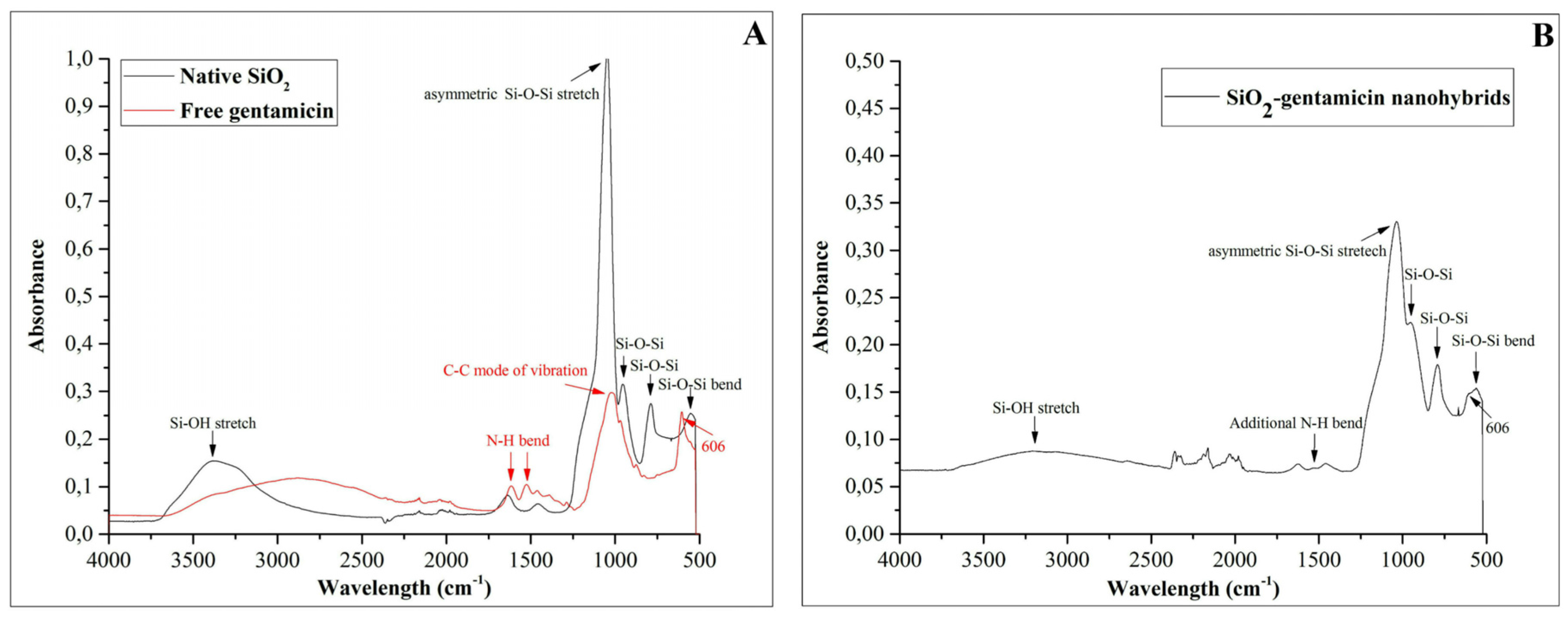
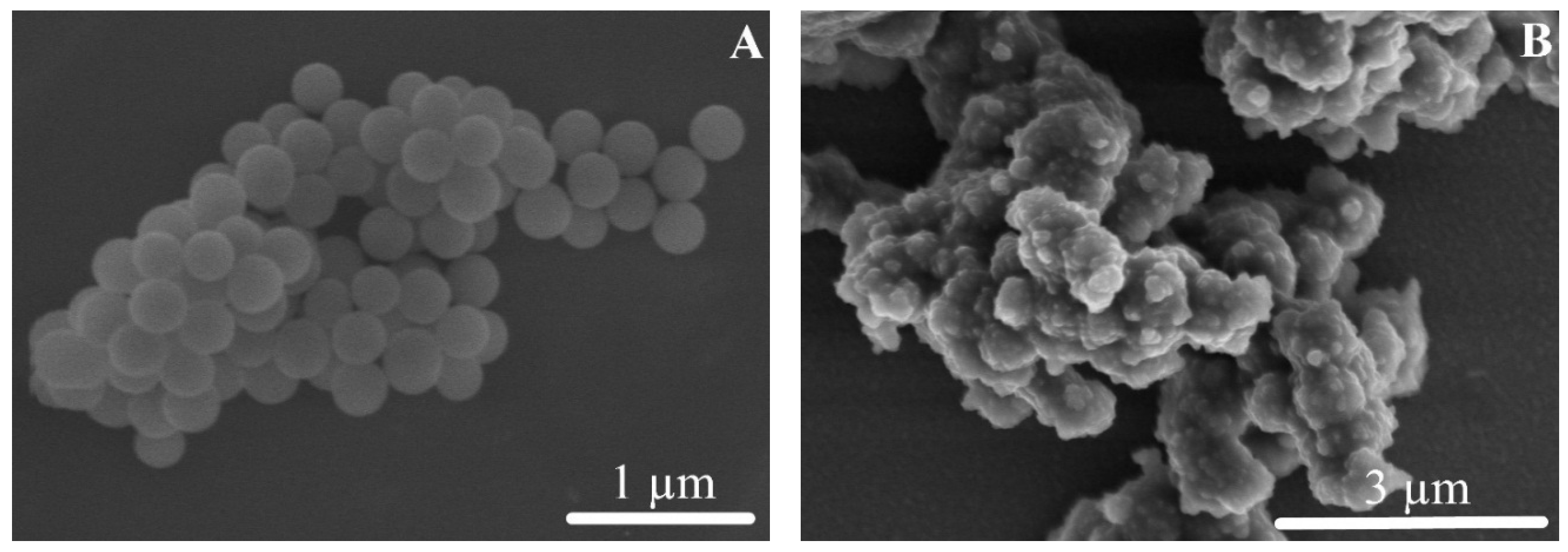
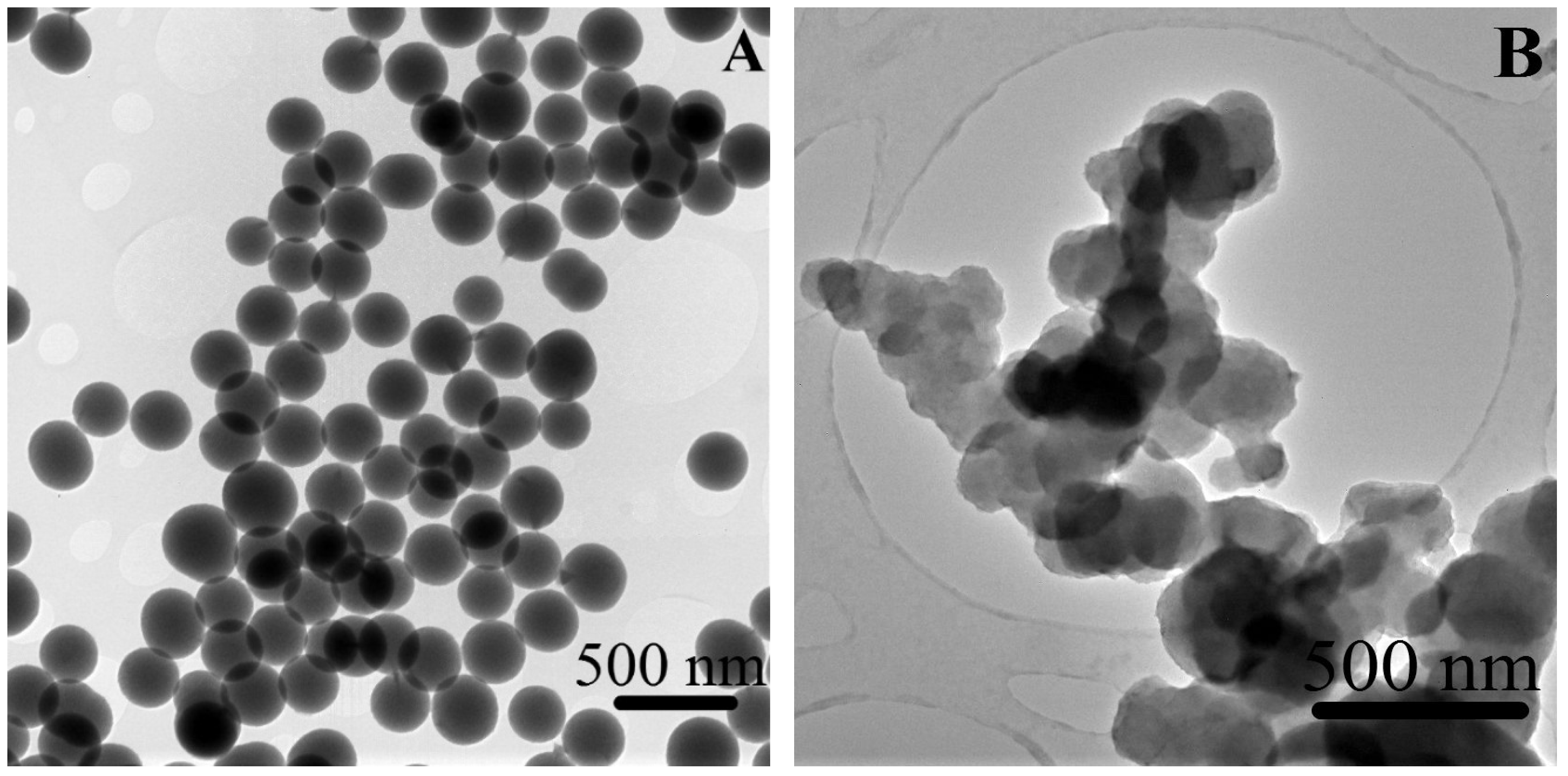
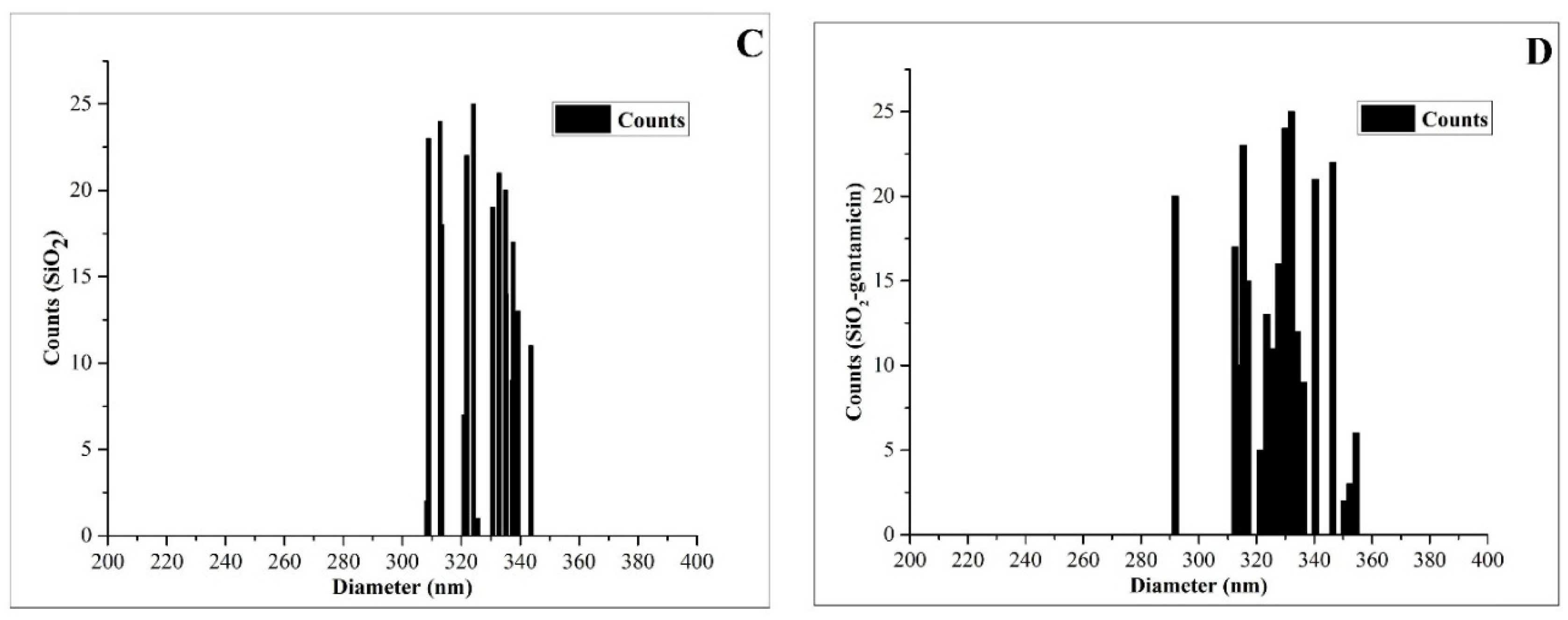
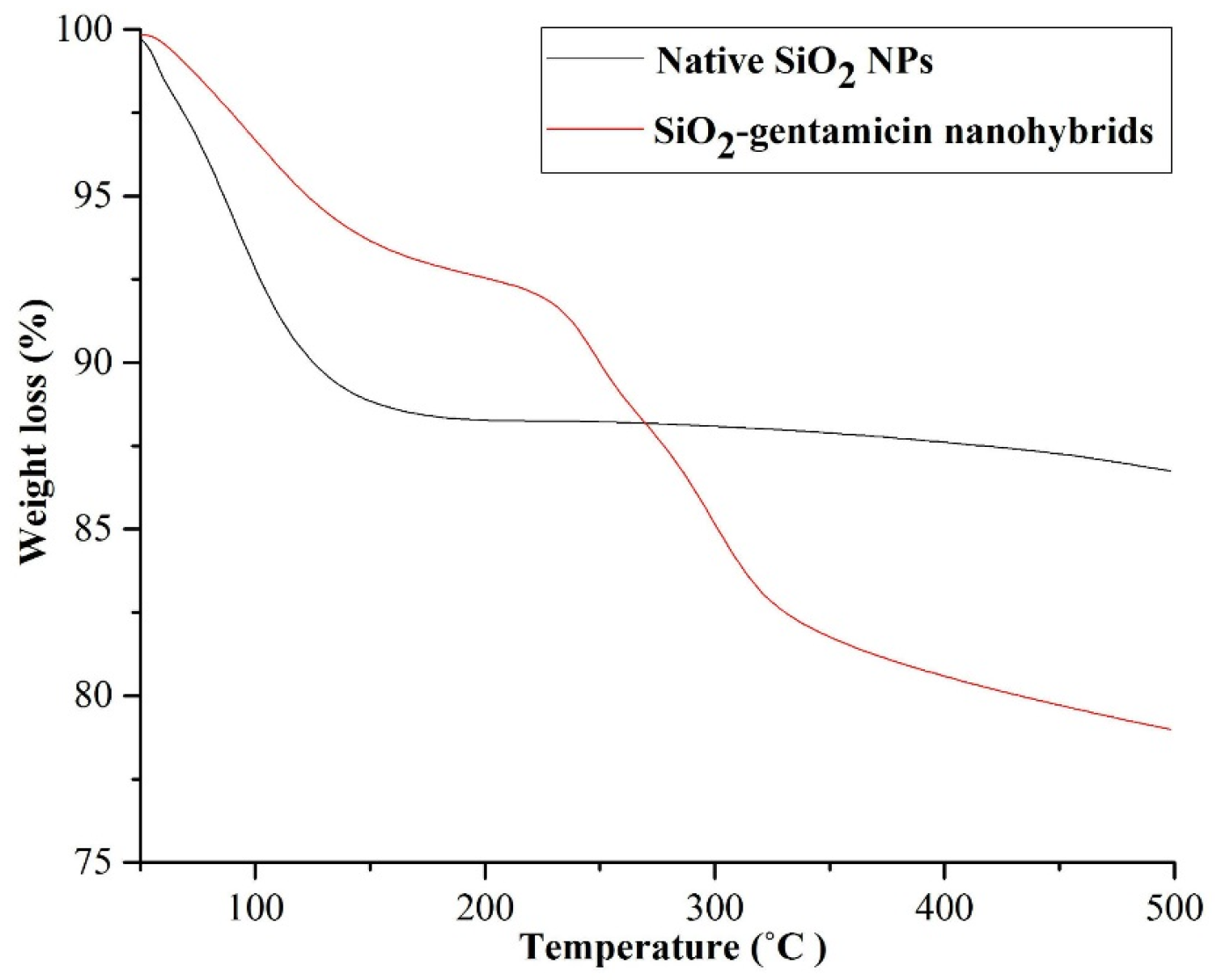
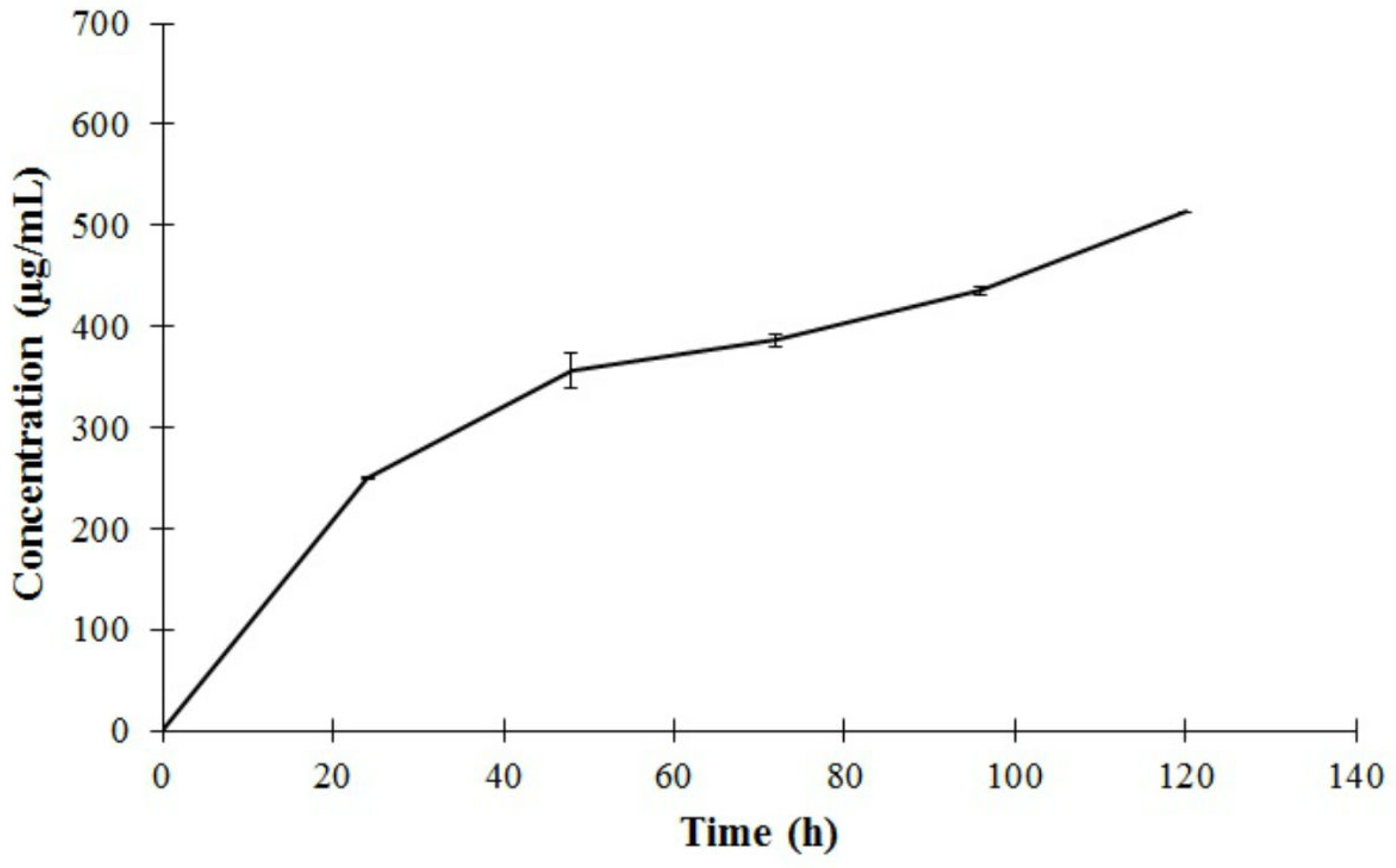




| Mathematical Models | Ks | R2 |
|---|---|---|
| Zero-order model | 2.5167 | 0.9662 |
| First-order model | 1.1519 | 0.9655 |
| Higuchi model | 0.8583 | 0.9721 |
| Korsmeyer–Peppas model | 0.966 | 0. 9769 |
| Tested Materials | MIC (µg/mL) | ||
|---|---|---|---|
| B. subtilis | P. fluorescens | E. coli | |
| Native SiO2 NPs | - | - | - |
| SiO2-gentamicin nanohybrids | 250 * | 250 * | 250 * |
| Free gentamicin | 0.98 | 3.91 to 15.63 ¶ | 3.91 to 15.63 ¶ |
© 2016 by the authors; licensee MDPI, Basel, Switzerland. This article is an open access article distributed under the terms and conditions of the Creative Commons by Attribution (CC-BY) license (http://creativecommons.org/licenses/by/4.0/).
Share and Cite
Mosselhy, D.A.; Ge, Y.; Gasik, M.; Nordström, K.; Natri, O.; Hannula, S.-P. Silica-Gentamicin Nanohybrids: Synthesis and Antimicrobial Action. Materials 2016, 9, 170. https://doi.org/10.3390/ma9030170
Mosselhy DA, Ge Y, Gasik M, Nordström K, Natri O, Hannula S-P. Silica-Gentamicin Nanohybrids: Synthesis and Antimicrobial Action. Materials. 2016; 9(3):170. https://doi.org/10.3390/ma9030170
Chicago/Turabian StyleMosselhy, Dina Ahmed, Yanling Ge, Michael Gasik, Katrina Nordström, Olli Natri, and Simo-Pekka Hannula. 2016. "Silica-Gentamicin Nanohybrids: Synthesis and Antimicrobial Action" Materials 9, no. 3: 170. https://doi.org/10.3390/ma9030170






